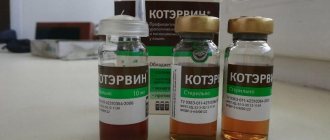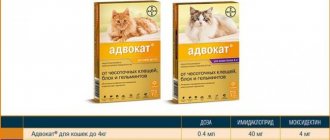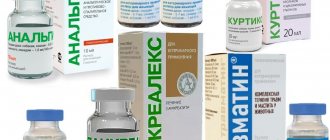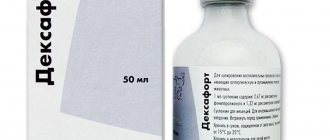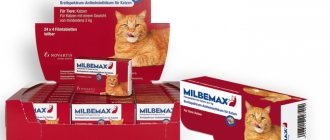- Posted by Olesya Vakhraneva
- Date: December 12, 2018
Veterinarians, when prescribing antibacterial therapy for cats, often opt for the drug Stomorgyl. Knowing some of the features of this remedy, the owner of a sick pet will better understand the healing process, and therefore assist it more effectively.
- 2 The mechanism of action of Stomorgyl
- 3 Indications for use
- 4 How to use Stomorgyl correctly
4.1 Video: how to give a pill correctly
- 4.2 Features of the use of the drug in kittens and pregnant cats
- 8.1 Table: comparison of the drug Stomorgyl with the combination of Spiramycin and Metronidazole
Composition and release form of Stomorgyl
Stomorgyl is a combined antibacterial agent with an expanded spectrum of effects on pathogenic microflora. It is produced by the French company (Merial).
Stomorgyl is produced in tablet form for oral administration. The tablets are voluminous and round in shape. One side of each tablet contains a score to facilitate division during dosing. The drug is available in three dosages. The color of the tablets depends on their dosage: Stomorgil 2 tablets are pink, Stomorgil 10 are red, Stomorgil 20 are purple. The weight of the tablets also differs; it is 120 mg, 650 mg and 1200 mg, respectively.
Tablets are placed in blisters of 10 pieces; blisters are packed in cardboard boxes; each pack contains 1 or 2 blisters with the drug, as well as an annotation on its use.
The drug Stomorgyl is available in tablets of three dosages
Composition of Stomorgyl:
- Active ingredients: Stomorgyl 2: spiramycin 150,000 IU;
- metronidazole 25 mg;
- spiramycin 750,000 IU;
- spiramycin 1500 000 IU;
- aluminum hydroxide;
The back of the package provides brief information on the use of Stomorgyl
Cases of antibiotic prescription for cats
Stomorgyl is prescribed to cats for the complex treatment of bacterial diseases of the oral cavity:
- gingivitis (gum inflammation);
For inflammation of the gums in cats (gingivitis), veterinarians prescribe antibacterial therapy with Stomorgyl.
- stomatitis (ulcerative lesions of the oral cavity);
- pyorrhea (gum disease, which leads to damage to the membrane surrounding the tooth roots; this disease is fraught with tooth loss);
- periodontitis (inflammation of the tooth root and nearby soft tissues).
The use of Stomorgil is advisable at the initial stage of development of the disease or at the stage of its progression.
Mechanism of action of Stomorgyl
The effect of the drug Stomorgil is determined by the combination of the effects of its active ingredients:
Spiramycin is an antibacterial substance belonging to the group of macrolides, which blocks protein synthesis in the cells of microorganisms, which leads to their death. Shows its activity in relation to:
- bordetell;
- actinomycete;
- bacteroids;
- campylobacter;
- corynebacteria;
- clostridium;
- chlamydia;
- eubacteria;
- fusobacteria;
- leishmania;
- mycoplasmas;
- rickettsia;
- listeria;
- Neisseria;
- staphylococci;
- streptococci;
- Legionella
After administration, it is easily absorbed from the lumen of the digestive system, quickly distributed throughout tissues and organs, as well as biological fluids of the body. The maximum content of spiramycin in the blood is achieved after 4–6 hours, in saliva after 4–8 hours.
Stomorgil tablets are equipped with marks for their division
Metronidazole belongs to the group of nitro-5-imidazoles and has activity against bacteria and protozoa:
- amoeba;
- gardnerell;
- giardium;
- trichomonas;
- bacteroids;
- coccidia;
- clostridium;
- eubacteria;
- fusobacteria;
- mycoplasmas;
- peptococci;
- peptostreptococci;
- porphyromonas;
- prevotell;
- spirochete;
- Veillonella.
After administration, metronidazole is quickly absorbed from the digestive system, reaching maximum levels in the blood and saliva within an hour after administration. Metabolized in the liver.
The active ingredients of Stomorgil, as well as the products of their metabolism, leave the body, excreted by the kidneys, intestines and mammary glands in lactating cats.
When assessing the degree of impact on living organisms, Stomorgyl is classified as a moderately hazardous compound. If the prescribed dosage regimen is followed, it does not have:
- development of allergic reactions in cats;
- toxic effects on the embryo, leading to termination of pregnancy in the early stages;
- toxic effects on the fetus, leading to the formation of gross malformations, stillbirth and limited viability.
Splitting Stomorgyl tablets is allowed only at risk
Action of the medication
The effectiveness of the drug is due to the simultaneous effect of two components on pathogenic microflora. The antibiotic binds to the ribosome of the microorganism's cell, leading to irreversible changes, as a result of which protein synthesis is disrupted and the bacterium dies.
The antiprotozoal component affects protozoa, suppressing their reproduction. If the dosage is chosen correctly, then by the end of the course of treatment it is possible to completely eliminate the pathogenic microflora. Like all antibiotics, this drug has a systemic effect on the body, quickly being absorbed through the mucous membranes of the gastrointestinal tract into the blood.
The active components are metabolized in the liver and then evacuated along with feces and urine from the animal’s body.
Indications for use
Stomorgyl is prescribed to cats for:
- treatment of oral pathology: periodontal diseases;
- stomatitis;
- gingivitis;
- pyorrhea - a purulent complication of inflammatory diseases of the oral cavity;
Considering the spectrum of action of the drug, Stomorgyl can be used for:
- infections of the skin and soft tissues;
- infectious diseases of the upper and lower respiratory tract;
- infectious lesions of the reproductive system;
- arthritis;
- mastitis.
Stomorgyl is most often prescribed by veterinarians for inflammatory diseases of the oral cavity.
When is the medicine prescribed?
The medication is prescribed to eliminate purulent lesions of the skin, internal organs and oral cavity, as well as in case of infection with Giardia and other protozoan microorganisms. The drug is used for the treatment of cats and dogs whose infectious disease occurs in the acute stage. The medicine is especially effective for gums affected by streptococcal or staphylococcal flora, as well as for pyorrhea.
The medication is often used for rare diseases in cats such as trichomoniasis and amoebiasis.
How to use Stomorgyl correctly
Stomorgyl is used at the rate of 75,000 IU of spiramycin and 12.5 mg of metronidazole per 1 kg of pet weight:
- 1 tablet of Stomorgil 2 is designed for 2 kg of cat weight;
- 1 tablet of Stomorgil 5 is designed for 5 kg of cat weight;
- 1 tablet of Stomorgil 20 is designed for 20 kg of the weight of a very large cat.
The tablet cannot be crushed; only dividing according to the existing risk is permissible. An attempt to split the tablet in another way will result in a violation of the dosage and loss of the therapeutic effect.
If you are tempted to crush or crush the tablet in order to quietly feed it to your cat, it is better to refrain from doing so. The product is very bitter, and there is hardly anything that can mask its taste. You will have to force feed the tablet by placing it on the root of the cat's tongue. After this, the cat should be offered water. Some cats start drooling from the bitter taste of the tablet. It is preferable to use a tablet dispenser.
The drug is given to the cat once a day; the connection with food intake is not noted in the manufacturer’s instructions, but it is better to take Stomorgyl after meals to reduce nausea caused by the metronidazole contained in the composition. The average duration of therapy is 5–10 days. The duration of the course, as well as the dosage of the drug, can be increased on the recommendation of the treating veterinarian.
No specific therapeutic effects were noted either during the initial administration of the drug or upon completion of therapy. You should avoid skipping the next dose of the drug, as this may result in a loss of therapeutic effectiveness; If a dose is missed, it should be resumed as soon as possible, without changing either the treatment regimen or the prescribed dosage of the drug.
When treating with antibacterial drugs of the macrolide group, it is very important not to skip doses, since the effect of macrolides in the usual dosage is bacteriostatic; they disrupt the functions of the bacterial cell, but do not kill it directly. The death of bacterial cells occurs due to functions disrupted by the antibiotic. If you skip taking the drug, the bacteria will not only survive and recover, they can become resistant to the effects of antibacterial drugs, including cross-resistance, when the bacteria becomes resistant to several groups of antibiotics at once. Therefore, compliance with the dosage and duration of treatment with antibiotics allows not only to cure the disease, but also to prevent the formation of bacterial strains that are resistant to antibiotics.
Video: how to give a pill correctly
Features of the use of the drug in kittens and pregnant cats
Stomorgyl is not recommended for use in pregnant or lactating cats, or in kittens under 2 months of age. On the other hand, pregnancy and lactation are not contraindications for the use of Stomorgyl, which can be prescribed for health reasons to a pregnant or lactating cat, while the kittens will be transferred to artificial feeding, since Stomorgyl is actively secreted into milk.
Administration of medication to an animal
While taking the medicine, those around you should remain calm, talk quietly to the cat, and pet it. Excitement and anxiety can frighten the animal and make it wary. If the owners are not confident in their actions, then it is better to use the help of a specialist.
The approach to the animal should be individual, depending on the nature of the pet: calm or hot-tempered.
Some tips:
- The process must take place with the participation of at least 2 people, one will hold the head, the second the animal.
- The cat's head needs to be tilted back a little.
- Press your fingers on the gum where the teeth are missing to release the lower jaw.
- For better glide, the tablet should be dipped in vegetable oil.
- Place the tablet on the root of the tongue.
- Pour water into the animal's mouth for a sip.
In order to make the procedure as safe as possible, you need to use a blanket, or purchase a special cage for this purpose at the veterinary store.
When working with this medicine, you should be guided by the principles of personal hygiene and safety precautions. Before using the medicine and after it, you should thoroughly wash your hands with soap and water.
For people who are highly sensitive to the components of the drug, it is necessary to avoid direct contact with the drug . If an allergy occurs or the medicine is ingested, you must urgently seek help from the hospital. Doctors must provide instructions for the drug or a box of it.
Contraindications and side effects of Stomorgyl
When using Stomorgil according to its instructions, there are usually no complications or side effects.
A contraindication to treatment with Stomorgyl is individual hypersensitivity to the components of the drug, including those previously identified.
For cats with decompensated liver, kidney and cardiac function, Stomorgyl therapy is carried out under the supervision of the treating veterinarian.
If the dosage regimen is violated, an overdose may occur, the symptoms of which are:
- oppression;
- salivation;
- indigestion.
If an allergy to the drug occurs, treatment with Stomorgyl is interrupted, symptomatic therapy is used, as well as an antihistamine (Pipolfen, Tavegil).
Stomorgyl can be prescribed to a pregnant cat for health reasons
Storage conditions and price
The medicine should be stored in a place away from direct sunlight and with air humidity of no more than 50%, at a temperature range of 4 to 25 degrees, in intact packaging. The drug should be out of reach of children and pets; contact with food and feed should be avoided.
The shelf life is no more than 3 years, subject to all the above conditions. After the expiration date, the medicine should not be used. Unused drug must be disposed of in accordance with the requirements of regulations on the destruction of drugs and medicines.
On average, the price of the drug is 500-1500 rubles and depends on the dose of the drug.
Approximate cost and existing analogues
There are no direct analogues of the drug Stomorgyl containing similar active ingredients yet. Comparison with a combination of medications is possible.
Table: comparison of the drug Stomorgyl with the combination of Spiramycin and Metronidazole
| A drug | Compound | Indications | Contraindications | Price, rub |
| Stomorgil | Spiramycin, metronidazole |
| Hypersensitivity to drug components |
|
| Combination Spiramycin + Metronidazole | Spiramycin | Bronchitis, pneumonia, infections of the ENT organs, bones, joints, reproductive system, urinary tract infections | Hypersensitivity to the components of the product |
|
| Metronidazole | Diarrhea of various origins, ulcerative gingivitis, giardiasis, dysentery, mastitis, skin infections |
| from 10 |
When comparing the characteristics of the drugs, attention is drawn to the inconvenient dosage for cats of both the Russian Spiramycin-Vero and the original French Rovamycin, in which it corresponds to the content of spiramycin in Stomorgyl 20. Depending on the weight of the cat, there may be some economic advantage from There is no such replacement, but it will not be possible to accurately dose human medications for cats.
Drugs with similar effects - table
| Name | Release form | Active components | Indications | Contraindications | Can it be used to treat pregnant cats? | Can it be used to treat kittens? | Price |
| Stomadex | Pills | Chlorhexidine acetate | Infectious and inflammatory lesions of the gums | Individual intolerance | Carefully | No | From 300 rub. |
| Intramycin | Suspension for injection |
| Bacterial infections of the respiratory tract, soft tissues, gums and internal organs. | Kidney failure | Not recommended | No | From 550 rub. |
Feedback from cat owners
After 3 days of taking Stomorgil, the cat began to eat normally and painlessly and the smell went away from his mouth. And we forgot about it for almost a year and thought that everything was cured. But the inflammation began again and more intensely, turned into a chronic form, and the torment began every two to three months. The drugs and ointments have changed, but of all of them, I only single out Stomorgyl. The drug is of course expensive, but its effectiveness with the correct dosage is simply off scale. The cat could not eat at all, shied away from food, and after one meal, he could at least swallow without chewing small pieces.
Anuta777
https://irecommend.ru/content/bystrodeistvuyushchii-i-effektivnyi
Stomorgil has very high efficiency. Within a day, it relatively relieved the pain and inflammation and the cat began to show interest in food (milk, kefir, broth), and after the second dose this foul smell from the mouth almost disappeared. And already on the third or fourth day, dry food was snatched away from the big cat. The only thing is that because the shell was broken, the cat had diarrhea (but I only gave it for 5 days) and/or because she couldn’t eat and drank only warm milk. Now, after Stomorgil and a course of treatment with an immunomodulator (Gamavit) and a probiotic, the animal is quite healthy, active, eats with appetite and is gradually getting used to it.
Marvelous777
https://otzovik.com/review_6092764.html
Analogs
There is no complete analogue with the same properties. You can give metronidazole and spiramycin separately, which are also available in tablets.
Metronidazole has antibacterial properties, but only acts on microorganisms that are sensitive to metronidazole. Compared to Stomorgil, it has a narrower effect.
Spiramycin is also used for oral infections, but is less effective. Therefore, replacement is possible, but only in situations where there is intolerance to one of the components of Stomorgyl.
The drug helps to cope with bacterial infections in cats in a short period of time. The effect of its use manifests itself very quickly, all the animal’s symptoms disappear; with any other medications the cat would have to be treated twice as long.

